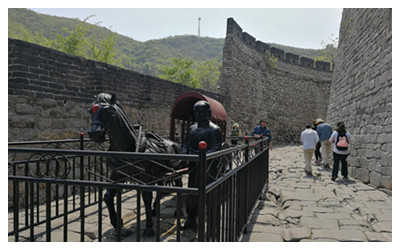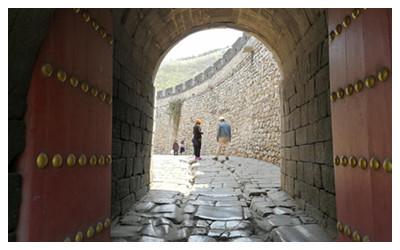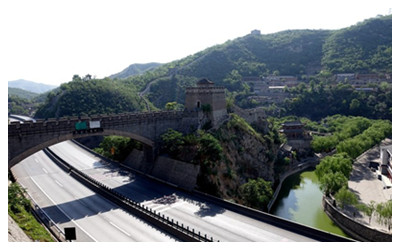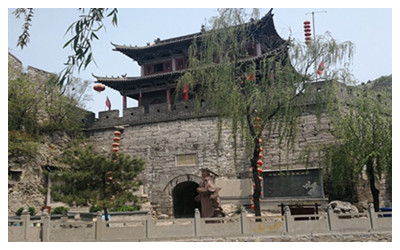Skype: neodalle-travel
Tel: +86 135 7447 2266
E-mail: sales@visitaroundchina.com
Guguan Great Wall is the only well-preserved stone Great Wall. It is located in Pingding County, Yangquan City, Shanxi Province, about 15 kilometers from the grand Niangzi Pass. Owing to its strategic location and difficulty of access, the Guguan Great Wall served as an important military strong hold in east Shanxi Province, together with Niangzi Pass and Jiuguan Pass.
History of Guguan Pass
Guguan Great Wall was first constructed in 369 BC by Zhongshan State during the Eastern Zhou Dynasty (770-256BC), 155 years earlier than the Great Wall built by Emperor Qin Shi Huang. However, what you see today are mainly relics from Ming Dynasty (1368-1644).
Wha to see?
From 1998 to 2003, Guguan Pass was repaired by the villagers living at its foot. They are said to be the descendents of the soldiers who once guarded the pass. They could not bear to see the heritage built by their forefathers remain dilapidated, so they decided to raise funds to reconstruct it. Finally, most parts were restored to the original state and opened to visitors in 2003.
 Guguan Pass City
Guguan Pass City
Guguan Pass is one of the four famous passes to the west of the capital Beijing during the Ming Dynasty. The other three are Juyongguan Pass, Zijingguan Pass, and Daomaguan Pass. Originally, the pass was located in Jiuguan Village, and called Jiuguan Pass. In 1543 during the Ming Dynasty, the Jiuguan Pass was attacked because its location was not precipitous enough. Therefore, a new pass was built to its west, which is known as Guguan Pass, meaning a solid pass.
The pass has two gates: the West Gate and East Gate. As enemies mainly came from the west, the West Gate is firmer than the East Gate. Over the West Gate is a two-storey gate tower. There is also a barbican outside the West Gate. Entering the barbican, you can see the ancient post road paved with smooth stone slabs. You can find deep and narrow ruts along the road because carriages passed by year after year in the ancient times. Seeing them, you will have a strong sense of the passage of time. In contrast, the East Gate is not as splendid as the West Gate.
 Inside the pass, you can find three administrative offices (called Yamen in ancient China): Big Yamen, Medium Yamen, and Small Yamen. To the east of the pass is the Stele Corridor, near which you can see the Statue of Han Xin (a brilliant general during the Western Han Dynasty), and the exhibition hall of the Guguan Great Wall. To the south of the pass was a cavalry drill ground, which used to be composed of Platform for Appointing Commanders, arrow rest, raceway and archery pavilion.
Inside the pass, you can find three administrative offices (called Yamen in ancient China): Big Yamen, Medium Yamen, and Small Yamen. To the east of the pass is the Stele Corridor, near which you can see the Statue of Han Xin (a brilliant general during the Western Han Dynasty), and the exhibition hall of the Guguan Great Wall. To the south of the pass was a cavalry drill ground, which used to be composed of Platform for Appointing Commanders, arrow rest, raceway and archery pavilion.
It is noteworthy that there are many temples in and around the pass: the Temple of the Dragon King near the West Gate, the Laoye Temple near the Big Yamen, the Sanguan Temple by the Medium Yamen, the Temple of the God of Literature near the East Gate, etc. The most impressive ones are the Temple of Guan Yu (a loyal and righteous general during the Eastern Han Dynasty), the Temple of Laomu (Mother of Emperor Shun), and the Temple of Xuanwu (a constellation god) on the Xifeng Mountain to the west of the pass.
Guguan Great Wall
 The existing section of Guguan Great Wall is 20 kilometers long. It can be divided into two sections: Northern Section and Southern Section. The Northern Section is about 13 kilometers long, running north from the pass, via Cenhoudi to Jiayugou at Niangzi Pass. The Southern Section extends 7 kilometers southward from the pass, via Jiangjunyu to Baihuikou. The stone wall sits on the crests of mountains, and is about 2 meters wide, and 3 meters to 4 meters high.
The existing section of Guguan Great Wall is 20 kilometers long. It can be divided into two sections: Northern Section and Southern Section. The Northern Section is about 13 kilometers long, running north from the pass, via Cenhoudi to Jiayugou at Niangzi Pass. The Southern Section extends 7 kilometers southward from the pass, via Jiangjunyu to Baihuikou. The stone wall sits on the crests of mountains, and is about 2 meters wide, and 3 meters to 4 meters high.
The beacon towers, emplacements and sentry posts were built at significant points on the wall. At present, there are eleven emplacements and mounds, three enemy towers, two beacon towers, one sentry post, and one ammunition tower in existence.
How to Tour Guguan Great Wall ?
 1. Enter the pass from the West Gate, and start your visit. You can enjoy the grand gate tower, have a walk on the ancient post road, and see the temples, Stele Corridor and Exhibition Hall close by.
1. Enter the pass from the West Gate, and start your visit. You can enjoy the grand gate tower, have a walk on the ancient post road, and see the temples, Stele Corridor and Exhibition Hall close by.
2. Afterwards, you may ascend the Great Wall Bridge from the gate tower and go north, and you will reach the Northern Section of the Great Wall. This section was laid with unpolished stones. The adhesive between the stones was the mixture of glutinous rice congee and lime. Go straight for about 550 yards (500 meters), you will come across an enemy tower. Keep going north and pass another enemy tower, turn west, and you will see the wild wall. The first several hundred meters of the wall were badly collapsed. Five to six hundred meters further, the wall is recognizable. The northern side of the wall is almost as tall as a man, and the southern side uses the mountain slope as the natural barrier.
3. The Southern Section of the wall is basically same as the northern section except there is a restored beacon tower laid by the original stones.
4. The stone wall is uneven and precipitous. You need to be careful and mind your steps.
Travel Tips
Address: Pingding county, Yangquan city, Shanxi province
Opening Hours: 08:00-17:30
Entrance Fees: CNY 30
 Ask Questions ?
Ask Questions ?